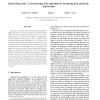Free Online Productivity Tools
i2Speak
i2Symbol
i2OCR
iTex2Img
iWeb2Print
iWeb2Shot
i2Type
iPdf2Split
iPdf2Merge
i2Bopomofo
i2Arabic
i2Style
i2Image
i2PDF
iLatex2Rtf
Sci2ools
101
click to vote
ICDE
2004
IEEE
2004
IEEE
Hash-Merge Join: A Non-blocking Join Algorithm for Producing Fast and Early Join Results
This paper introduces the hash-merge join algorithm (HMJ, for short); a new non-blocking join algorithm that deals with data items from remote sources via unpredictable, slow, or bursty network traffic. The HMJ algorithm is designed with two goals in mind: (1) Minimize the time to produce the first few results, and (2) Produce join results even if the two sources of the join operator occasionally get blocked. The HMJ algorithm has two phases: The hashing phase and the merging phase. The hashing phase employs an in-memory hash-based join algorithm that produces join results as quickly as data arrives. The merging phase is responsible for producing join results if the two sources are blocked. Both phases of the HMJ algorithm are connected via a flushing policy that flushes in-memory parts into disk storage once the memory is exhausted. Experimental results show that HMJ combines the advantages of two state-of-the-art non-blocking join algorithms (XJoin and Progressive Merge Join) while ...
Database | Hash-based Join Algorithm | Hash-merge Join Algorithm | ICDE 2004 | Non-blocking Join Algorithm |
| Added | 01 Nov 2009 |
| Updated | 01 Nov 2009 |
| Type | Conference |
| Year | 2004 |
| Where | ICDE |
| Authors | Mohamed F. Mokbel, Ming Lu, Walid G. Aref |
Comments (0)

